

Communion
“Our Father Who art in Heaven, hallowed be Thy name; Thy kingdom come, etc… and forgive us our trespasses as we forgive those who trespass against us. And lead us not into temptation but deliver us from evil. Amen.”

The Priest Purifies the Paten
“Deliver us, O Lord, from all evils past, present, and to come; and by the intercession of the Blessed Virgin Mary, and of all the saints, grant that we may be always free from sin through Christ our Lord. Amen.”
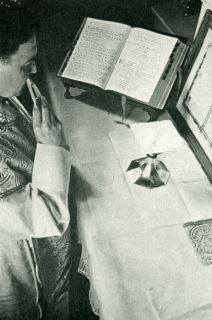
The Priest Kisses the Paten
“Graciously grant peace in our days, through the help of Thy bountiful mercies.”
The cause of our trouble in the world is sin. Peace of soul and a perfect resignation to the goodness of God present in the Most Blessed Sacrament destroys hatred and the possibility for sin.
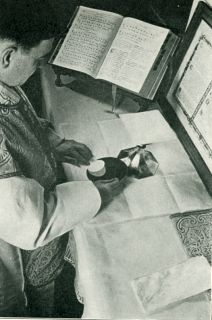
The Priest Places the Host On the Paten

The Breaking of the Host

A Small Particle of the Host is Commingled with the Wine
“May this commingling and Consecration of the Body and Blood of our Lord Jesus Christ obtain for all who receive It eternal life.”
(As we mentioned before, it was a custom in the early Church to use a small particle broken from the large Consecrated Host for the Communion of the Faithful.)

Agnus Dei (The Lamb of God)
“Lamb of God, Who takest away the sins of the world, have mercy on me.”
In Masses for the Dead, the faithful say (interiorly):
“Give them rest.”

The Priest Removes the Host from the Paten
“I will take the bread of Heaven and call upon the name of the Lord.”

“O Lord, I Am Not Worthy”
“Lord, I am not worthy that Thou shouldst enter under my roof, only say the word and my soul shall be healed.”
After each recitation of this prayer, the server rings the bell (three times).

The Communion of the Body of Our Lord by Priest
“May the Body of our Lord Jesus Christ keep my soul unto life everlasting.”
Having received the Host, the priest with eyes cast down, pauses to pray silently for a few moments.

Preparation for Communion of Chalice
“What shall I render to the Lord for all the things that He hath rendered unto me?”
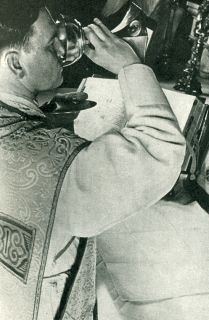
The Communion of the Chalice
“I will take the Chalice of salvation, and call upon the name of the Lord. Praising, I will call upon the Lord, and I will be saved from my enemies.”
The priest then makes the sign of the cross before himself with the Chalice saying:
“May the Blood of our Lord Jesus Christ preserve my soul to life everlasting. Amen.”
At this point in the Mass the Faithful who are to receive Communion proceed to the Communion rail and those who cannot receive offer up their hearts and souls in spiritual Communion. Spiritual Communion is nothing more than a real and sincere desire and wish to receive our Lord in Holy Communion if you could.

The First Ablution
“O my Jesus, I firmly believe that Thou art present in the most adorable Sacrament; I love Thee above all things. I desire to receive Thee into my heart. Come, my Jesus, I give Thee my heart and my soul; let me be united to Thee forever. Amen.”
The servers proceed to the Epistle side or right hand side of the altar with the cruets containing the unconsecrated wine and water. The celebrant, standing at the altar, received wine only for the first ablution saying:
“Grant, O Lord, what we have taken into our mouths may be received with a pure mind: as a temporal gift, may it become unto us an eternal remedy."
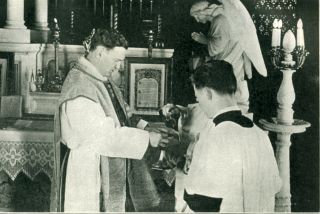
The Second Ablution
"May Thy Body, O Lord, which I have received, and Thy Blood which I have drunk cleave to my heart...”

The Priest Reassembles the Articles Used at the Holy Sacrifice
“Thou art the Good Shepherd Who hast given Thy life for Thy sheep. Have mercy on the Church. Guard and guide our Holy Father, the Pope, bless our bishops and protect and guide our pastors.”

Preparation for After the Communion

The Dominus Vobiscum
“The Lord be with you.” (“Dominus Vobiscum”)
The servers answer,
“And with Thy Spirit.” (“Et cum spiritu tuo”)
The priest then returns to the right side of the altar again.

The Last Oration
“Thou, O God, has kindly allowed us to have a part in this Holy Sacrifice; for this we give Thee thanks. Accept it now to Thy glory and be ever mindful of our weakness. Amen.”
These prayers are called Post-communion since they follow as a thanksgiving after Communion. Mention is always made of the Body and Blood of Christ which has been received. At the conclusion of these prayers, the priest closes the Missal and returns to the center of the altar.

The Last Blessing
“Dominus Vobiscum”
and requests the blessing of the Lord before the congregation saying,
“The blessing of God Almighty, the Father, the Son and the Holy Ghost descend upon us and dwell forever in our hearts. Amen.”
You will observe that the priest does not sign himself but raises his hands in benediction over the congregation.
Continue with the...
|
| Return to top of page |
| Bookmark this site |
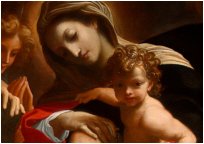
© StGemma.com Web Productions Inc. 2005-PRESENT. All rights reserved.

Appendix I
Appendix II
Appendix III
Appendix IV
Gregory XVII "Siri"
The Coming Great Catholic Monarch St. John Bosco's Dream (Vision) of Hell
Michael Dimond:
Original St. Michael Prayer (Exorcism)
Antichrist
Home
(Altar & Sanctuary Guide)
(Server Instructions)
(Pronunciation of Latin)
(Pius V Quo Primum)
The Pope in Red
a False Prophet
(Catholic Prophecy)
